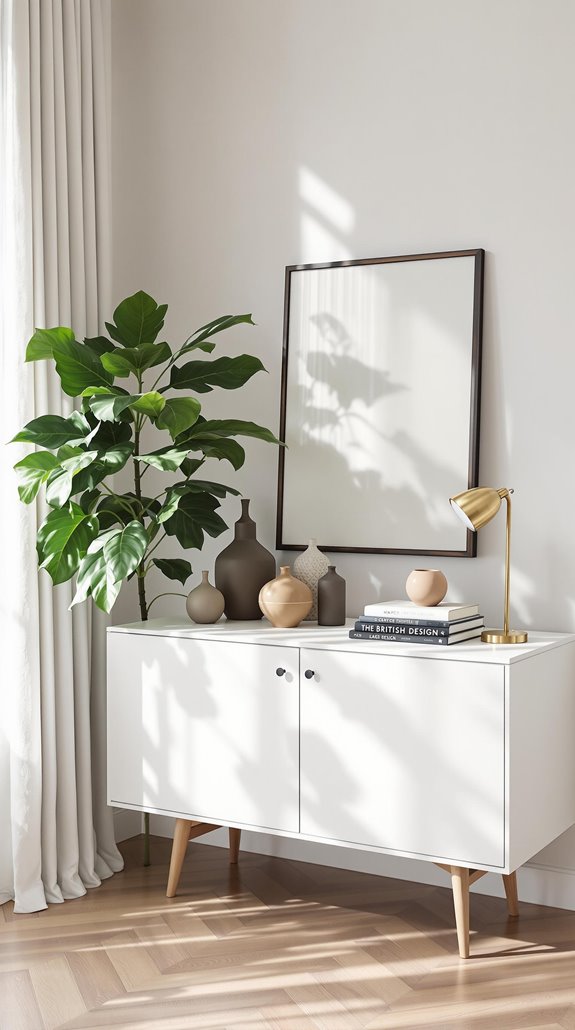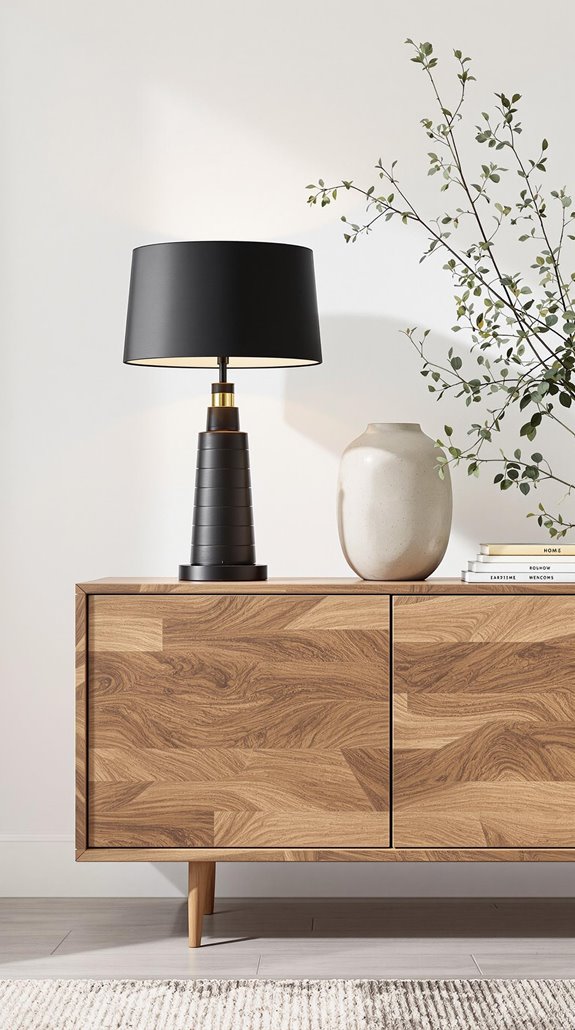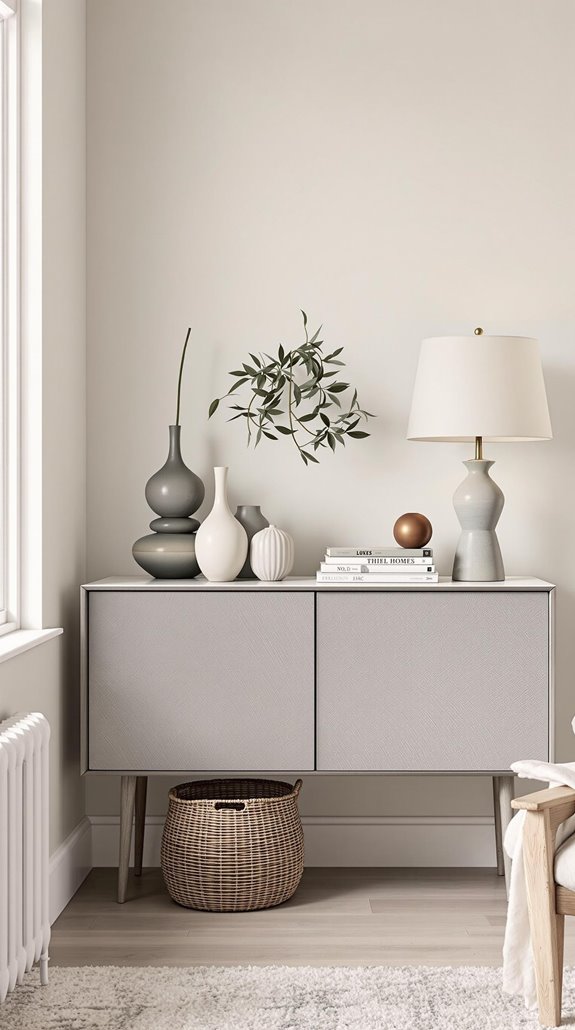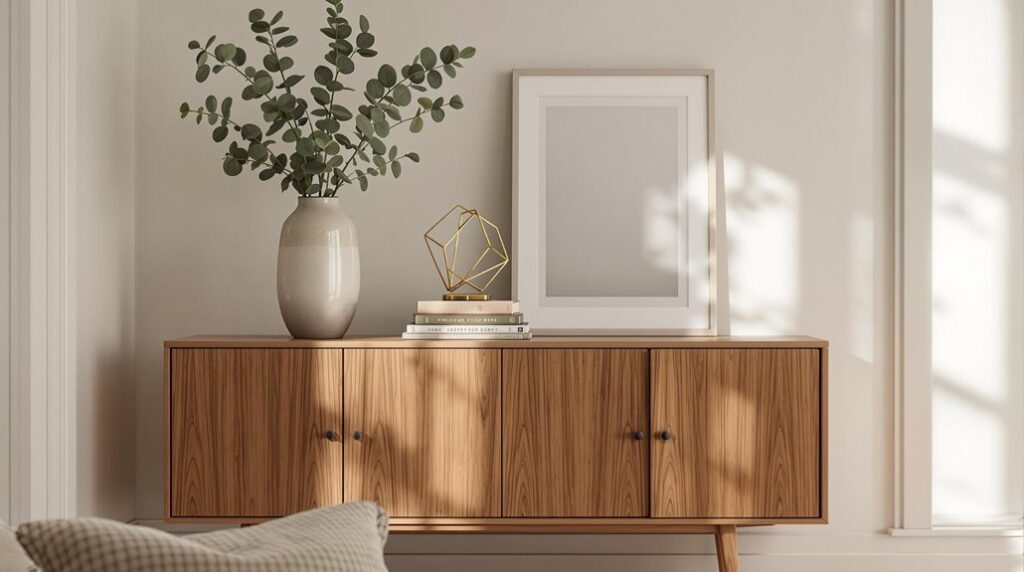I’ve discovered that most people struggle with sideboard styling because they treat it like a storage dumping ground rather than a design opportunity. When I work with British homeowners, I notice they’re often intimidated by the process of creating that effortless, magazine-worthy look. The truth is, there’s a specific formula I use that transforms any sideboard into a sophisticated focal point—and it doesn’t require expensive pieces or perfect symmetry to achieve stunning results.
Key Takeaways
- Apply the rule of odd numbers by arranging decorative objects in groups of three or five for natural visual balance.
- Create asymmetric arrangements with the tallest piece on one side, balanced by medium-height objects on the opposite end.
- Mix materials following the 70-20-10 rule, combining wood, stone, and metal proportions for sophisticated contrast.
- Layer items by depth, placing larger pieces at the back and smaller decorative objects in front for dimensional interest.
- Limit your colour palette to three core shades, using natural wood tones with accent colours like navy or terracotta.
Essential Sideboard Styling Principles for Modern British Homes

When styling a sideboard in your British home, I’ll focus on five core principles that transform functional furniture into statement pieces.
First, I’ll use the rule of odd numbers—arrange objects in groups of three or five with varying heights to create dynamic visual interest. Additionally, consider incorporating layering light within your sideboard display to enhance the overall ambiance of the room. Second, I’ll coordinate your backdrop by aligning wall art with your sideboard display, ensuring they complement rather than compete.
Third, I’ll layer functionality by storing everyday items in lower compartments while curating beautiful surface displays. Consider incorporating biophilic integration through small potted plants or natural elements that bring organic texture to your contemporary interior. Fourth, I’ll choose materials that belong together—think oak with fluted glass panels and patinated brass hardware for authentic British character.
Finally, I’ll stick to cohesive color palettes using 3-4 complementary hues, incorporating mid-century tones like muted blues and earthy accents for sophisticated harmony.
Mastering Asymmetric Arrangements and Visual Balance
Creating visual balance without perfect symmetry requires strategic placement of objects across your sideboard’s surface. I’ll show you how to master this essential styling technique that transforms ordinary furniture into stunning focal points.
Start with the rule of three—group items in clusters of three for natural balance. Place your tallest piece (like a table lamp) on one side, then balance it with two medium-height objects on the opposite end. I always vary heights by stacking books as pedestals or using different-sized vases.
Create color partnerships throughout your arrangement. If you’ve got black candles on your white sideboard, echo that contrast elsewhere with dark picture frames or accessories. Mix metallic trays with porcelain pieces and glass frames to add visual interest through varied textures. Layer items by depth, positioning larger pieces toward the back and smaller decorative elements forward for visual depth.
Material Mixing Techniques: Wood, Metal, and Stone Combinations

Beyond arranging objects with visual balance, the materials of your sideboard itself form the foundation of your styling success. I recommend starting with the 70-20-10 rule: dominant wood, secondary stone, and accent metal proportions prevent overwhelming UK rooms.
Stone tops like Grigio Portofino marble create elegant contrast against warm timber bases, while quartzite surfaces handle high-traffic areas brilliantly. I’ve found brass handles on mango wood introduce Art Deco glamour, whilst blackened iron frames with light ash achieve that coveted Scandinavian-modern hybrid look. Additionally, it’s wise to consider affordable renovation costs when selecting materials to ensure that your design remains within budget.
For functionality, stone withstands heat up to 300°C—perfect for kitchenware placement. Remember to seal unsealed stone every 6-12 months and run wood grains perpendicular to stone veins to avoid visual clutter in compact spaces. Consider glass-front sideboards when working with limited dining room dimensions, as they create an illusion of openness whilst maintaining storage capacity.
Colour Palette Strategies for Timeless Appeal
While material combinations establish your sideboard’s structural foundation, colour choices determine whether your styling endures seasonal trends or requires constant updating. I recommend starting with monochrome schemes—black, white, and grey create striking contrast that never dates. You’ll achieve sophistication by limiting your palette to three core shades, ensuring cohesion across your living space. Additionally, a well-maintained garden can significantly enhance your home’s overall value, making your interior styling even more impactful.
Natural wood tones offer reliable warmth. Light oak works beautifully in contemporary settings, while grey oak balances traditional appeal with modern restraint. I’ve found that celebrating natural grain patterns enhances authenticity. Consider incorporating wall lights to elevate the ambiance and create a more premium feel throughout your space.
For accent colours, navy blue evokes luxury against pale surfaces, while terracotta introduces grounded sophistication. If you prefer softer approaches, mint green or blush pink lends airy freshness to minimalist schemes without overwhelming your space.
Strategic Placement and Functional Considerations for Every Room

Although your sideboard’s aesthetic appeal matters, its placement determines whether it becomes a functional asset or decorative obstacle in your home. I’ll guide you through strategic positioning that maximises both form and function.
In hallways, choose pieces under 120cm width to preserve flow while creating intentional arrival moments. You’ll want drawer storage for keys and cabinet space for bags. Keep decorations minimalist to maintain a welcoming atmosphere without overwhelming the space. For dining rooms, position within arm’s reach of your table and prioritise sliding doors in tight spaces to eliminate clearance issues.
In living areas, I recommend using sideboards as media storage with finished backs for open-plan suitability. Bedrooms benefit from large statement pieces over 150cm in corners, whilst narrow profiles work beside beds. Always maintain 60cm clearance in multi-functional spaces to preserve traffic flow.
Conclusion
I’ve shown you the core techniques that’ll transform your sideboard from cluttered surface to design feature. Apply the rule of three, mix your materials strategically, and stick to a cohesive color scheme. Don’t forget placement matters—match your styling to each room’s function. You’ve got the tools now. Start with one section, build your arrangement methodically, and you’ll create a sideboard that’s both beautiful and genuinely useful for daily life.
References
- https://www.fcilondon.co.uk/blog/small-sideboard-design-trends/
- http://gracie-senseandsimplicity.blogspot.com/2011/09/5-ways-to-style-your-sideboard.html
- https://www.youtube.com/watch?v=2WwNDsnW_1k
- https://www.idealhome.co.uk/living-room/living-room-trends-241173
- https://www.housebeautiful.com/room-decorating/living-family-rooms/g63095381/living-room-trends-2025/
- https://www.pavilionbroadway.co.uk/blog/sideboard-styling/
- https://westernliving.ca/homes-and-design/homes/9-genius-ways-to-style-your-sideboard/
- https://www.scoutandnimble.com/blog/sideboard-styling-how-to-style-a-sideboard-like-a-designer
- https://www.idealhome.co.uk/dining-room/dining-room-decor/styling-a-sideboard
- https://www.fishpools.co.uk/blogs/inspiration/how-to-dress-a-sideboard

